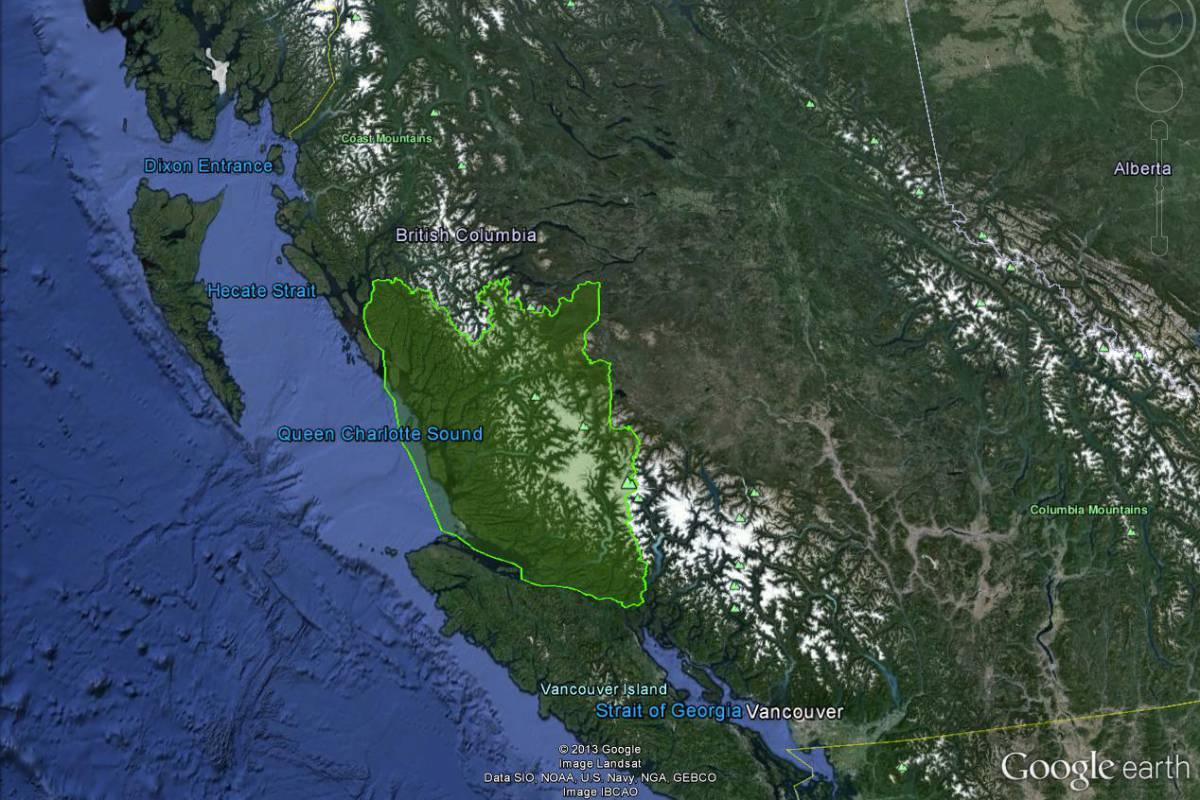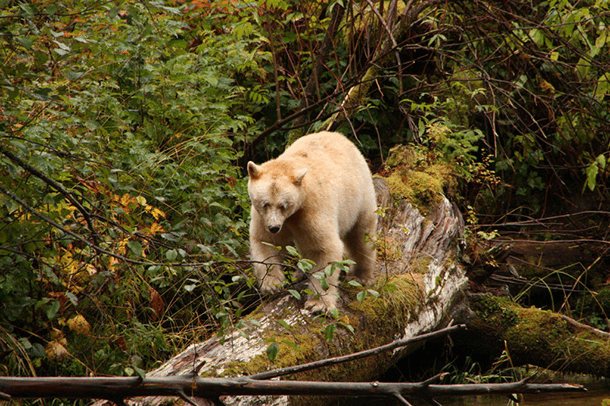A new agreement protects most of Canada’s Great Bear Rainforest from logging
A white Spirit bear in the Great Bear Rainforest — the only place on Earth where these bears can be found.
After decades of negotiation, an agreement has been reached that will protect 85 percent of the Great Bear Rainforest in British Columbia from logging. The agreement was hammered out among environmental activists, the timber industry, First Nations and the BC government.
The Great Bear Rainforest covers an area of 6.5 million hectares (about 21 million acres) between the top end of Vancouver Island and the Alaska Panhandle and is the only place in the world where one can see the Kermode (Spirit) bear, a sub-species of black bear noted for its white fur. The rainforest is usually described as the largest intact temperate rainforest in the world — a very lush, mossy, moist, year-round ecosystem.

Fights over the rainforest go back at least 30 to 40 years, says Andrew Macleod of the Vancouver-based magazine, The Tyree. The region used be known as the Mid-Coast Timber Supply until environmentalists renamed it in 1997 as the start of a campaign to save it.
The environmental movement in BC is strong and healthy, Macleod says. “This is the birthplace of Greenpeace; David Suzuki and the Suzuki Foundation are here, Sierra Club is strong. A group called Forest Ethics were involved [in the agreement], as well.”
But British Columbia is politically divided, Macleod says. The BC government itself is part of the logging industry. BC Timber Sales is a government company and is one of the license holders in the rainforest.
“There are a lot of people working in resource industries who are all for logging and paving it, and the government, for the most part over the history of the province, has been involved in encouraging that,” Macleod says. “And there a lot of people who are here because it's beautiful — people who don't directly depend on resource jobs, but are here because they like the place.”
After years of fighting for the rainforest “valley by valley,” Macleod says, “environmentalists sat down and said, ‘Well, what's the next big battle and how do we fight in a way that makes sense?’”
So they started what Macleod calls a markets campaign. “There are five main forest companies that hold licenses up there, and they went to their customers and basically said, ‘We’ll make it uncomfortable for you if you want to take trees from here and turn them into toilet paper and books and such. We'll make it clear where they're coming from and what the destruction is like on the land.’”
Macleod believes the threat of the markets campaign gave industry and government the incentive to negotiate. “It gave forest products from British Columbia a bad name,” Macleod says. “We were the Brazil of the north. I think the logging companies didn't want to go through that again.”
Adding to that, he says, Canada’s First Nations have in recent years seen their rights re-established. “There have been some precedent-setting cases just in the last few years that have recognized that aboriginal title does exist,” Macleod explains. “The first iteration of those court rulings said that First Nations people had to be consulted — the government could [no longer] just circle parts on a map and say, ‘Yeah, that's open for logging.’”
On the other hand, Macleod says, there are lots of people from First Nations who today are working in the logging industry, as well. In fact, an initial agreement, which involved BC’s First Nations in the negotiations, leaned heavily toward protection. But when the First Nations negotiators went back to their communities with the draft agreement, Macleod says, “a lot of the reaction they got was, ‘Wait a second, we need jobs here as well.’ They weren't necessarily all for protecting everything.”
And now, after 20 years of discussion, 10 years of serious negotiation involving 26 First Nations, five logging companies, three environmental groups, the provincial government and some local governments, an agreement has been reached. And while the agreement has been widely hailed as a model of collaboration, not everyone is happy with the outcome.
One of BC's leading environmental voices, Vicky Husband, told Canada's Globe and Mail that while "it is impressive that environmental negotiators were able to get so much when the government wanted to give so little … she is dismayed the deal has allowed the government to cast itself as green, when it is still allowing ancient forests to be logged and grizzly bears to be shot."
“The way they describe the agreement is ‘working forests,’” Macleod says. “It’s sort of open for logging, [under the] same kinds of standards as the rest of the province. The forest industry will tell you that that means protecting viewscapes, protecting old-growth, protecting habitat for species at risk. In this case, it will mean protecting bear dens. Critics will tell you that the logging industry always says that kind of thing and it will be destructive and damaging to the ecosystem.”
“On the other hand, the trade-off is that something like 85 percent of the remaining forest is being protected,” Macleod concludes. “The idea is that they have come to some kind of a balance that everyone can live with.”
This article is based on an interview that aired on PRI’s Living on Earth with Steve Curwood.
Every day, reporters and producers at The World are hard at work bringing you human-centered news from across the globe. But we can’t do it without you. We need your support to ensure we can continue this work for another year.
Make a gift today, and you’ll help us unlock a matching gift of $67,000!
